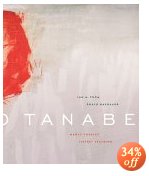Takao Tanabe

by Ian M. Thom, Roald Nasgaard, Nancy Tousley, Jeffrey Spalding
170 pages,
ISBN: 1553651413
Post Your Opinion | | Gift Books
by Olga Stein
This is not just a superbly produced book, with no expense spared on the quality of paper and colour reproduction, it is an expertly written book. An Introduction by Ian M. Thom details Tanabe's education at the Winnipeg School of Art (1946-1949), his year of studying at New York's Brooklyn Museum of Art School (1950-52), an Emily Carr Scholarship-sponsored period at London England's Central School of Arts and Crafts and travels throughout Europe (1953-55), as well as his two years in Japan (1959-61), where he learned the traditional art of calligraphy and sumi-e painting. The Introduction is followed by three lengthy, analytical, beautifully written chapters by Roald Nasgaard, Nancy Tousley and Jeffrey Spalding. Throughout the book, in fairly tight chronological order, and corresponding to the discussions of the various phases of Tanabe's career, are colour plates of the artist's work from the early 1950s to 2000.
In a short review it is impossible to do justice to either the artist, whose work is of unquestionable importance, or the critical narratives, which attest to the contributors' genuine devotion to the work. But not to acknowledge this fine book, which represents the first retrospective of Tanabe's art in print, would be a shame.
Known nowadays more for his minimalist "abstracted" landscapes-of western grasslands, prairies, ploughed fields-and somber, yet peaceful seascapes of islands glimpsed from a distance, obscured by "atmospheric haze and grey skies", it is important to remember that the geometric composition, the structural and colour simplification of these vistas, derives from Tanabe's experience with, and practice of, abstract art from the 1950s to early 1970s. Tanabe began his studies in Winnipeg under the tutelage of Joseph Plaskett, who had studied with the American modernist, Hans Hofmann, in New York. Eventually, Tanabe himself had the chance to study with Hofmann and to hobnob with "progressive" artists in New York. Influenced by the period's prevailing modernist concepts and techniques, he applied the cubist grid to many of his paintings, and for a period, experimented with geometric shapes of "hardened edges", and "high-keyed and commercial" colours "laid down flat and unmodulated." In the 1970s, the stylistically peripatetic artist began to focus on landscapes. Yet he continued to be wed to the principles of geometric abstraction and "spare, ordered composition". Jeffrey Spalding captures the spirit of these mesmerising works:
"Tanabe's prairie paintings conspire to pare down the particulars to a vestige emblematic of the scene. He pulls back, presenting the view as if witnessed from a great remove. . . The grandest formal dare occurs when his interventions are reduced to the very slightest, when he is able to deliver the most persuasively full visual sensation with the least explicit clues. . .we look past the particular to engage in a transcendent experience. . ."
|